Keta Salmon
Oncorhynchus keta
During spawning the look of the male changes. Among other things, he grows a beak called a kype that bears fangs.
Advertisement
Keta Salmon Scientific Classification
- Kingdom
- Animalia
- Phylum
- Chordata
- Class
- Actinopterygii
- Order
- Salmoniformes
- Family
- Salmonidae
- Genus
- Oncorhynchus
- Scientific Name
- Oncorhynchus keta
Read our Complete Guide to Classification of Animals.
Keta Salmon Conservation Status
Keta Salmon Facts
- Prey
- Smaller fish, zooplankton, insects, comb jellies, squid, mollusks, tunicates
- Group Behavior
- School
- Fun Fact
- During spawning the look of the male changes. Among other things, he grows a beak called a kype that bears fangs.
- Estimated Population Size
- in the millions
- Biggest Threat
- Climate change, habitat loss or degradation
- Most Distinctive Feature
- The blood red slash down the side of a breeding male
- Other Name(s)
- Chum salmon, dog salmon, silverbrite salmon, white salmon, autumn salmon, damaha fish
- Gestation Period
- 3-4 months
- Habitat
- Oceans, estuaries, coastal streams
- Predators
- Bears, humans, other fish, shorebirds, killer whales, sea lions, seals, stonefly larvae
- Diet
- Carnivore
- Type
- fish
- Common Name
- Chum salmon, keta salmon
- Number Of Species
- 1
View all of the Keta Salmon images!
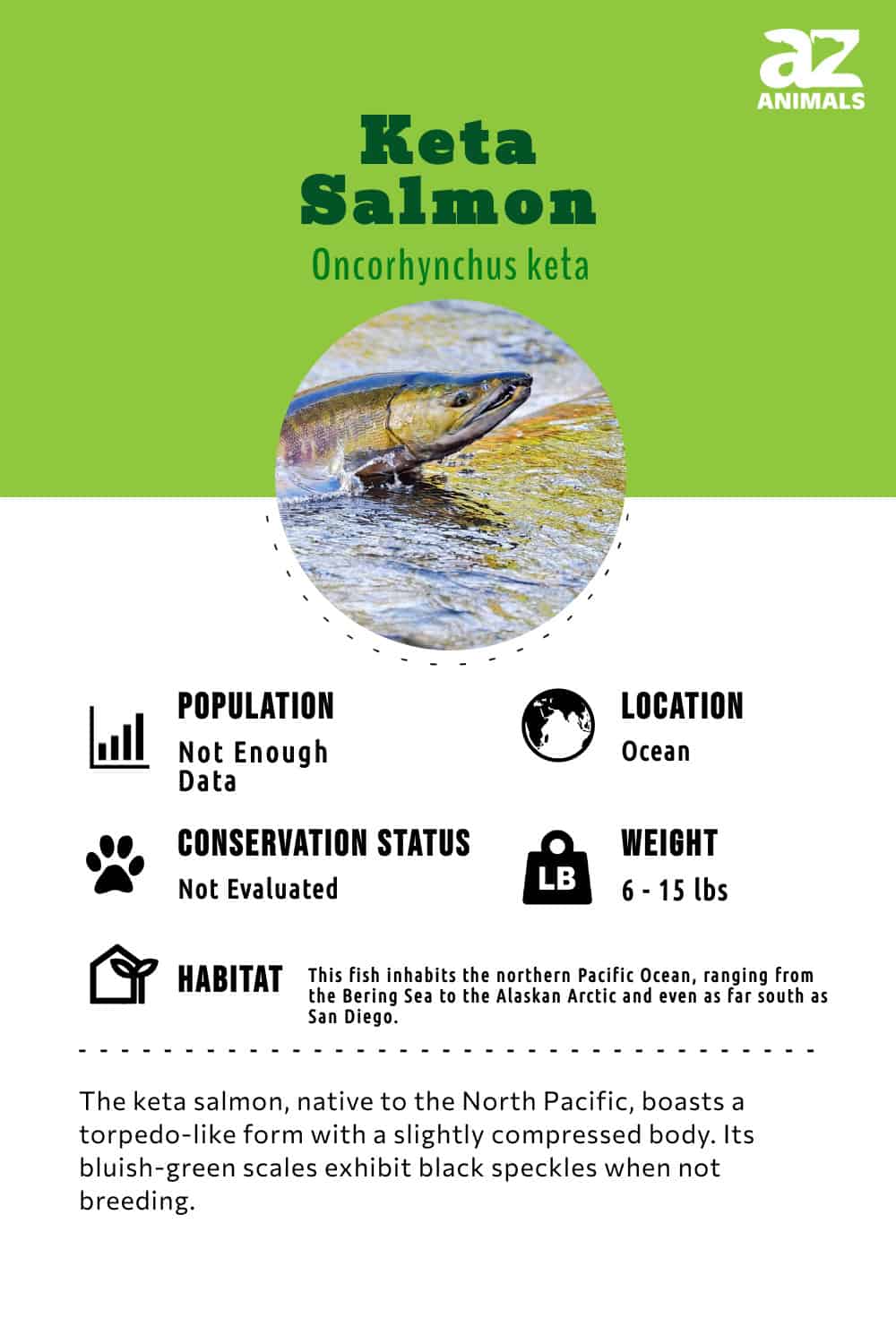
“The keta salmon is a salmon of the North Pacific”
Call it the keta, chum, dog, or silverbrite salmon, this medium-sized member of the Salmonidae family isn’t as majestic as the Chinook and doesn’t change its look as spectacularly as the sockeye.
Yet it is a worthy fish that features in a slew of recipes and whose meat is high in healthful omega-3 fatty acids. Read on for more information about the keta.
Four Amazing Facts About the Keta Salmon
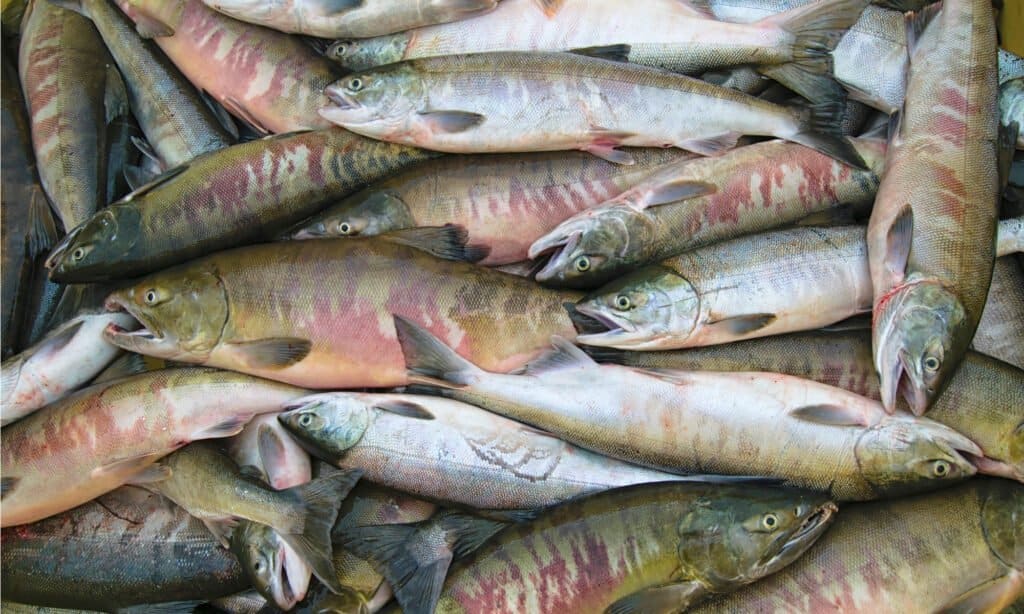
Wild keta are cold-water fish and prefer water that’s between 32 and 75.2 degrees Fahrenheit.
©Konstantin Baidin/Shutterstock.com
Here are four amazing facts about the Keta Salmon:
- Wild keta are cold-water fish and prefer water that’s between 32 and 75.2 degrees Fahrenheit.
- Some keta salmon swim as much as 2000 miles up the Yukon River to their spawning grounds.
- Keta salmon are anadromous which means they can live in both salt and fresh water.
- The keta salmon always dies after it spawns.
Evolution and Origins
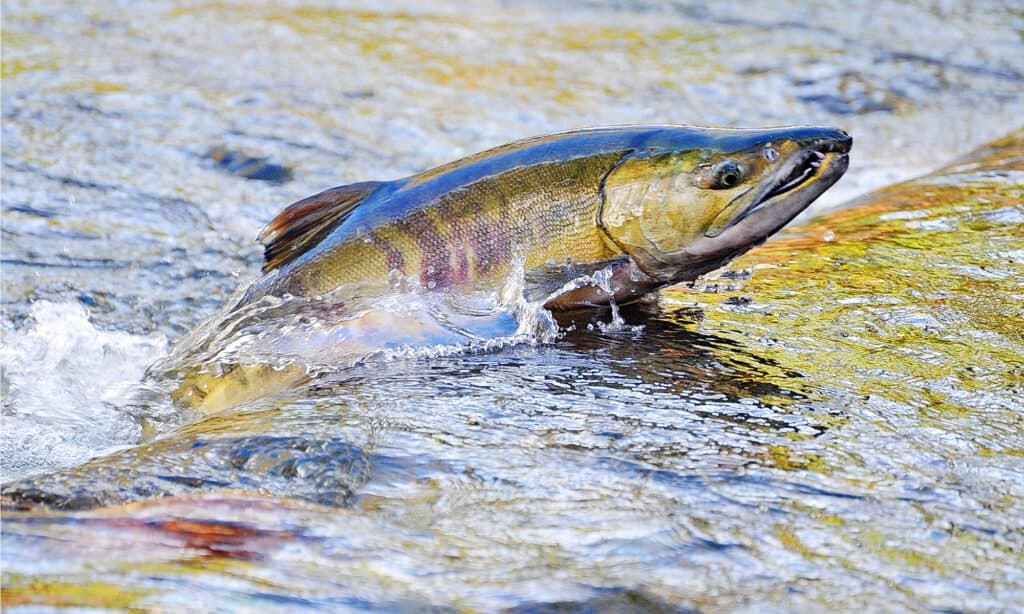
The keta salmon is a torpedo-shaped fish with a moderately compressed body and shimmering bluish-green scales with black speckles when not in the breeding season.
©The Old Major/Shutterstock.com
The chum salmon (Oncorhynchus keta), recognized as dog salmon or keta salmon, belongs to the anadromous salmonid fish group within the Oncorhynchus genus (Pacific salmon).
It originates from the coastal rivers of the North Pacific and the Beringian Arctic. This species is frequently sold under the trade name “silverbrite salmon” in North America.
The assortment of salmon species found in Alaska—namely chinook, coho, sockeye, chum, and pink—are thought to have originated from a shared ancestor with steelhead, which is also referred to as rainbow trout. These contemporary Pacific salmon varieties have an extensive history, dating back 4 to 6 million years ago.
Classification and Scientific Name
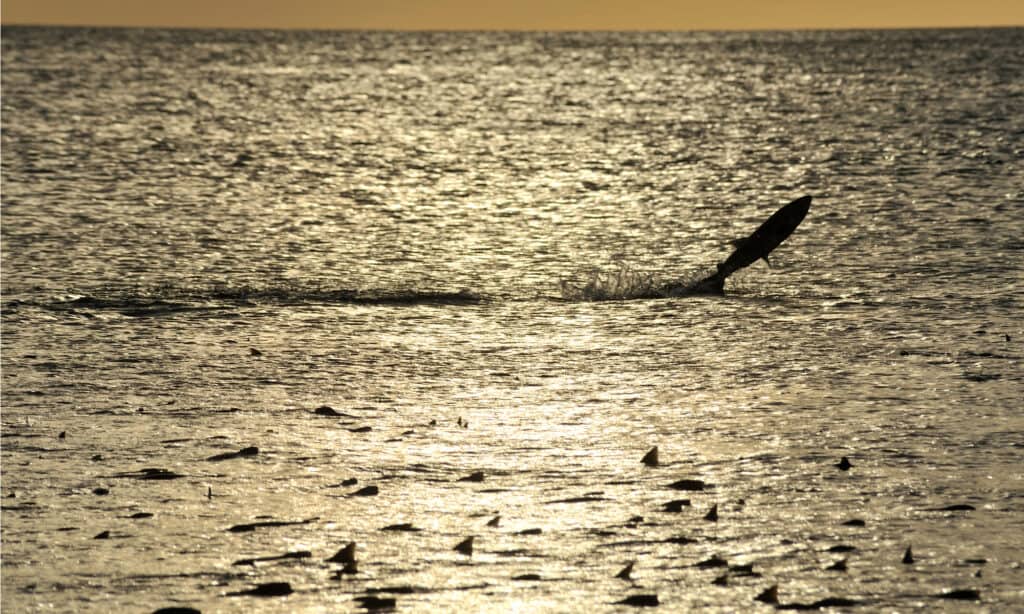
Keta salmon are mostly found in the Pacific and Arctic oceans.
©yamaoyaji/Shutterstock.com
The scientific name of the keta or silverbrite salmon is Oncorhynchus keta. The genus name comes from the Greek words ónkos, which means “lump” or “bend” and rhúnkhos, which means “snout.” This describes the hooked beak that the male salmon gets during the breeding season. Keta is a Russian word that is in term derived from Evenki, a language spoken in eastern Siberia.
Appearance
The keta salmon is a torpedo-shaped fish with a moderately compressed body and shimmering bluish-green scales with black speckles when not in the breeding season. It grows to an average of 23.6 inches with a weight of 9.7 to 35 pounds. The fish has 10 to 14 soft rays on its back, 13 to 17 soft anal soft rays, and an emarginate tail fin.
When they’re ready to spawn, the males turn dark olive green or black on their backs. The rest of their body is grayish-red and tiger-striped with black and red, and they have a streak along their side that looks very much like a bleeding gash left by a switchblade. The flesh, as with many salmon, is bright pinkish-orange and high in healthy omega-3 fatty acids.
Keta Salmon vs. Pink Salmon
The pink salmon is also called the humpback salmon because of the hump the fish develops during the spawning season. It is smaller than the keta salmon and is in fact the smallest of the North American Pacific salmon. They are more brilliantly silver than the keta, and their flesh is pinker in color.
Though the looks of both males and females change greatly during the breeding period, pink males not only have a notable hump but lack the red slash that’s prominent on the side of the keta salmon. Wild Alaskan keta salmon are the first fish to spawn followed by the pink salmon. The pink salmon lives for two years, another thing that differentiates them from the keta, which can live for three to five years.
Distribution, Population, and Habitat
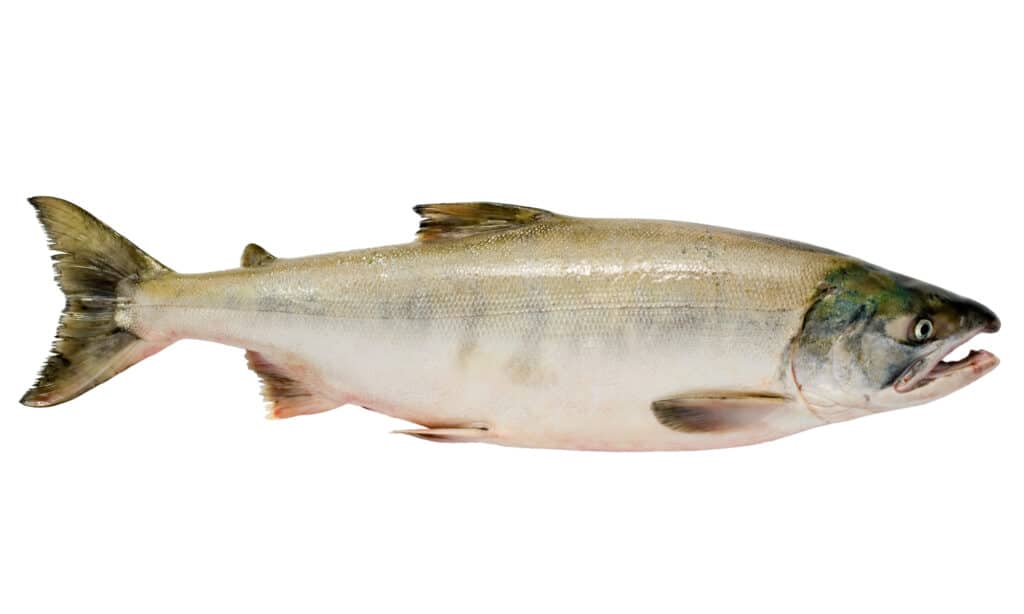
Keta salmon is also known as chum salmon.
©DoublePHOTO studio/Shutterstock.com
The keta salmon is found in the northern Pacific Ocean, the Bering Sea, the Alaskan Arctic, and as far south as San Diego. It’s also found in the waters off of Korea and Japan and is even found in Iran. The population is most likely in the millions, as millions of pounds of fish are harvested in Alaska alone.
The fish’s habitat changes according to its stage of life. The fish are born in intertidal zones and cold, freshwater streams with sandy or pebbly bottoms either in the late fall to winter or in summer.
In the spring and summer, they head down to the ocean, where they stay near the coast until they are large enough to head out to the open waters. Three or four years later, they famously return to the place of their birth to spawn.
Predators and Prey
Bears gather around streams to pluck up these salmon as they struggle to their spawning grounds, and eagles are seen eating their dead bodies after they’ve spawned. Other animals that eat the silverbrite salmon are killer whales, seals, sea lions, and shorebirds. Stonefly larvae, which also hatch in freshwater streams, sometimes make a meal of salmon hatchlings.
Prey of these fish includes smaller fish, squid, mollusks, copepods, comb jellies, plankton, and tunicates such as sea squirts. Juveniles eat insects before they turn to larger prey.
Reproduction and Lifespan
The dog salmon endures one of the longest migrations of any salmon species. Once it has finally returned to the stream where it was born, the female digs a hole that’s about 3 feet around and 1.6 feet deep called a redd. The male and female hover over the redd, vibrating and releasing eggs and sperm.
The female then covers the nest up. She digs another redd if she mates with another male. She may spawn two or three times, and the eggs hatch after three or four months. The larvae are about 0.63 inches long and begin their migration back to the ocean when they’re between 1 and 1.77 inches long.
After they spawn, the parents die. Their decaying bodies add nutrients to the water and aid in the growth of their babies.
Fishing and Cooking
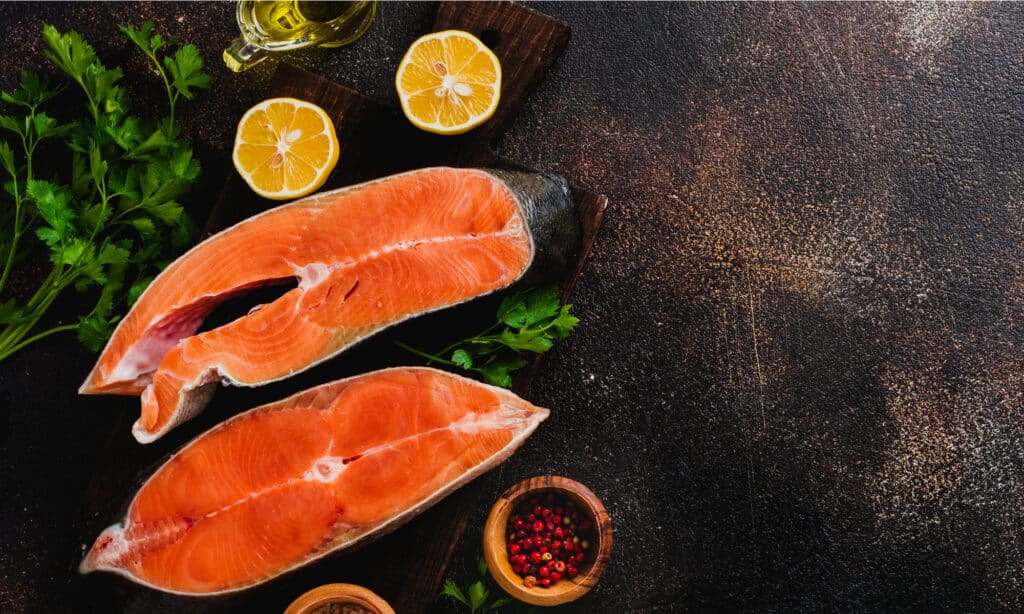
The taste of the fish is delicate and mild, and recipes call for it to be poached, pan-fried, baked, broiled, steamed, and eaten raw as sushi or sashimi.
©Katarzyna Hurova/Shutterstock.com
The keta salmon is a choice fish when it comes to cooking. The taste of the fish is delicate and mild, and recipes call for it to be poached, pan-fried, baked, broiled, steamed, and eaten raw as sushi or sashimi. The roe, or caviar of the salmon is also prized.
Salon caviar can be told from the caviar of sturgeons because it is red and the eggs are larger. As chum salmon are more plentiful than most species of sturgeon, salmon caviar can be considered more sustainable. Like a lot of salmon, the Silverbrite is a bit pricy. It can range from $19 to $26 a pound.
Commercial fisheries catch chum salmon using gill nets and purse seiners. Recreational fishermen use light tackle for saltwater and fly tackle for freshwater, though like most Pacific salmon, the chum is usually fished in the ocean since it doesn’t eat when it returns to spawn.
Population
Though it is not evaluated, the population of keta salmon is safely in the millions of individuals. The Alaskan population alone is probably 91 million fish. However, some populations are considered endangered, and different areas have different rules and regulations regarding harvesting fish.
View all 77 animals that start with KKeta Salmon FAQs (Frequently Asked Questions)
What is keta salmon?
The keta salmon is a type of Pacific salmon that is harvested for the delicious taste of its flesh and roe.
Is keta salmon healthy?
Keta salmon is very healthy. It is rich in omega-3 fatty acids as well as the B vitamins, especially vitamin B12.
What's the difference between Keta salmon and regular salmon?
A keta is a regular sort of salmon, right along with the Chinook, sockeye, pink and coho salmon. All of these salmon pretty much have the same life cycle and are good eating.
Which is better - keta or sockeye salmon?
It depends on your taste! Keta is considered mild and delicate and has a high moisture content. Because of this, many recipes call for wild keta to be roasted. Sockeye is rich, buttery and has a fishy taste that a lot of people crave. The price of the sockeye salon is competitive with the price of the keta. The price of sockeye can run from $15 to $30 a pound.
Why is Keta Salmon called dog salmon?
The keta salmon is probably called dog salmon because during the spawning season the male grows dog-like fangs.
Thank you for reading! Have some feedback for us? Contact the AZ Animals editorial team.


















